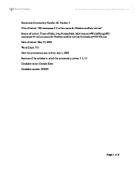Note that before Country A entered into the trade agreement with Country B, it is consuming 150 units of computers and 150 yards of clothes.
Country A has an absolute advantage in the production of clothes (employing all the available labor hours). And that Country B has an absolute advantage in the production of computers. However the concept of absolute advantage is not always necessarily true. Therefore we have to look at a broader concept which is the concept of comparative advantage. Comparative advantage means that a country has the lowest opportunity cost of producing a certain product; in producing one additional unit of the product in which it has comparative advantage, it will give up the least possible units of the other product.
Opportunity cost is the cost of using a resource measured in terms of the sacrifice foregone in the next best alternative. The following table shows the calculation of the opportunity cost of producing both goods in each country using the same amount of labor.
For Country A:
The cost of producing 1 yard of cloth = 200/600= 1/3 pc
The cost of producing 1 unit of PC = 600/200= 3 c
For Country B:
The cost of producing 1 yard of cloth = 600/200= 3 pc
The cost of producing 1 unit of PC = 200/600= 1/3 c
Therefore, Country A has a comparative advantage in the production of clothes since it has lower opportunity cost, and in the same way Country B has a comparative advantage in the production of computers. Therefore country A should specialize in cloth production, specialization; means a country exclusively allocate all its resources in the good that has a comparative advantage in.
In the case of most developing Asia’s countries, where labor is very cheap, they should specialized in labor- intensive manufactures which currently accounts to more than 50% of their total exports.
Suppose that Country A decided to enter into a free trade agreement with Country B and each specialize completely in the good of comparative advantage. So now Country A is producing 600 yards of cloth and Country B is producing 600 units of computers. And that the new trade price is 1 cloth= 1 PC.
Gains from trade
After trade, both countries consumption of both goods are on points that are outside the PPF (Diagram-3, -4). So everyone is now better off. This conclusion comes in line with the ADB report that ‘trade has long been a key driver in the Asian growth’.
Country A (Asian countries) also gained further advantage from removing the trade barriers, which enabled them to reach levels of product that were not achievable in autarky. First, by specializing they gain economies of scale which means that the cost of producing additional unit will be lower, and their output will also increase. Moreover, Greater competition drives local producers to cut costs and be more efficient. Consumers also benefits from trade by Diversification of the products that a consumer can enjoy. However, these benefits can limit through transport costs that can make it more expensive to trade. Add to that, because of lack of protectionism infant industry might suffer as they need time to expand and gain economies of scale and be able to compete on an international basis.







